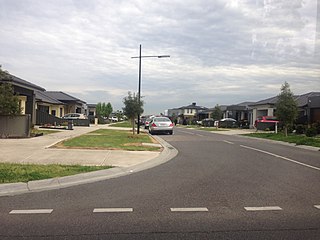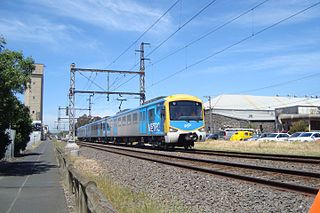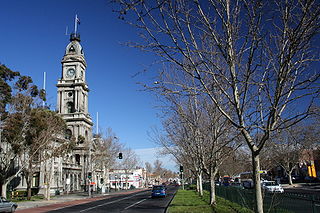
The Hume Highway, inclusive of the sections now known as the Hume Freeway and Hume Motorway, is one of Australia's major inter-city national highways, running for 840 kilometres (520 mi) between Melbourne in the southwest and Sydney in the northeast. Upgrading of the route from Sydney's outskirts to Melbourne's outskirts to dual carriageway was completed on 7 August 2013.

Craigieburn is a satellite suburb, located on the edge of Melbourne, Victoria, Australia, 25 km north of Melbourne's central business district. Its local government area is the City of Hume. At the 2016 Census, Craigieburn had a population of 50,347.

Brunswick is an inner-city suburb of Melbourne, Victoria, Australia, 6 kilometres (3.7 mi) north of Melbourne's central business district. Its local government area is the City of Moreland. At the 2016 Census, Brunswick had a population of 24,473.

Coburg is a suburb of Melbourne, Victoria, Australia, 8 km north of Melbourne's central business district. Its local government area is the City of Moreland, although a handful of properties on Coburg's eastern boundary are located in the City of Darebin. At the 2016 Census, Coburg had a population of 26,185.

Fawkner is a suburb of Melbourne, Victoria, Australia, 12 km north of Melbourne's central business district. Its local government areas are the City of Moreland and the City of Hume. At the 2016 Census, Fawkner had a population of 14,043.

Glenroy is a suburb of Melbourne, Victoria, Australia, 13 km north of Melbourne's central business district. Its local government area is the City of Moreland. At the 2016 Census, Glenroy had a population of 22,245.

Pascoe Vale is a suburb of Melbourne, Victoria, Australia, 10 km north of Melbourne's Central Business District. Its local government area is the City of Moreland. At the 2016 Census, Pascoe Vale had a population of 17,051.

The Upfield Shared Path is a shared use path for cyclists and pedestrians, which follows Upfield railway line through the inner northern suburbs of Melbourne, Victoria, Australia.

Hoddle Highway is an urban highway in Melbourne linking CityLink and the Eastern Freeway, itself a sub-section of Hoddle Main Road. Both these names are not widely known to most drivers, as the entire allocation is still best known as by the names of its constituent parts: Hoddle Street, Punt Road and Barkly Street. This article will deal with the entire length of the corridor for sake of completion, as well to avoid confusion between declarations.

Coburg North is a suburb of Melbourne, Victoria, Australia, 11 km north of Melbourne's central business district. Its local government area is the City of Moreland. At the 2016 Census, Coburg North had a population of 7,601.
The Brunswick Progress Association is a community organisation active in the City of Moreland Council area, and in particular the suburbs of Brunswick and Coburg, inner northern suburbs of Melbourne, Victoria, Australia. It was first established in 1905 and celebrated its centenary of community activism in 2005.

Pascoe Vale South is a suburb of Melbourne, Victoria, Australia, 10 km north of Melbourne's central business district. Its local government area is the City of Moreland. At the 2016 Census, Pascoe Vale South had a population of 10,069.

Brunswick Town Hall is located on the corner of Sydney Road and Dawson Street in the inner northern Melbourne suburb of Brunswick, Victoria, Australia.

Melbourne tram route 19 is operated by Yarra Trams on the Melbourne tram network. It operates from North Coburg to Flinders Street station. The 10.2 kilometre route is operated by B and D class trams from Brunswick depot.

Pascoe Vale Road is a major thoroughfare through the northern suburbs of Melbourne, connecting the outer northern fringe to the inner northern suburbs.

The City of Brunswick was a local government area in the inner-northern suburbs of Melbourne, Victoria, Australia. It comprised the suburbs of Brunswick, Brunswick East and West Brunswick. It ceased to exist on 22 June 1994, when its council was disbanded by the Kennett Government and replaced with appointed commissioners, who oversaw its amalgamation with the City of Coburg and parts of the City of Broadmeadows, to create the City of Moreland.

The State (Bell/Springvale) Highway, also known as Route 40 or the Bell Street/Springvale Road State Highway, is the longest self-contained urban highway in Melbourne, Australia, linking Tullamarine Freeway and Nepean Highway through Melbourne's north-eastern suburbs. These names are not widely known to most drivers, as the entire allocation is still best known as by the names of its constituent parts: Bell Street, Banksia Street, Manningham Road, Williamsons Road, Doncaster Road, Mitcham Road, Springvale Road and Edithvale Road. This article will deal with the entire length of the corridor for sake of completion, as well to avoid confusion between declarations.

The City of Coburg was a local government area about 10 kilometres (6 mi) north of Melbourne, the state capital of Victoria, Australia. The city covered an area of 19.44 square kilometres (7.51 sq mi), and existed from 1859 until 1994.

Royal Parade is a major urban road in Victoria, Australia, linking Melbourne City to Brunswick and the northern suburbs. It is the site of major educational and sporting facilities as well as several buildings of heritage significance.
The Melbourne, Brunswick & Coburg Tramway Trust was a tram operator in Melbourne, Australia

















